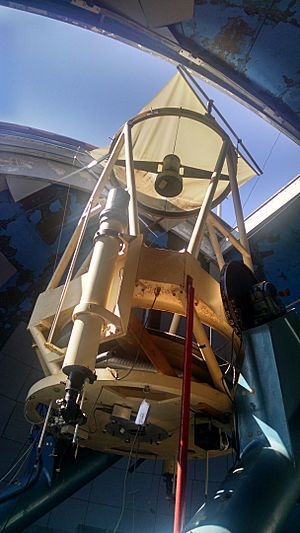Black Moshannon Observatory facts for kids
Quick facts for kids Black Moshannon Observatory |
|||||
|---|---|---|---|---|---|
| Organization | Pennsylvania State University | ||||
| Location | Black Moshannon State Park | ||||
|
Coordinates
|
40°55′19″N 78°00′18″W / 40.922°N 78.005°W
|
||||
| Altitude | 738 meters (2,421 ft) | ||||
| Established | 1972 | ||||
| Closed | after August 1995 | ||||
|
|||||
The Black Moshannon Observatory (BMO) was a special place where scientists used big telescopes to study space. It was owned by Pennsylvania State University. This observatory started in 1972. You could find it in the middle of Pennsylvania, inside Black Moshannon State Park. It was about 17 kilometers (11 mi) northwest of a town called State College. The observatory stopped being used sometime after August 1995.
Contents
Exploring the Black Moshannon Observatory
The Black Moshannon Observatory, or BMO, was an important place for astronomers. It helped them learn more about the universe. Even though it's no longer open, it played a role in understanding distant stars.
What Was the Main Telescope Like?
The observatory's most important tool was a large reflecting telescope. It measured 1.6 m (63 in) across. This type of telescope uses mirrors to collect light from space.
How Did Scientists Use the Telescope?
Attached to the telescope was a special instrument called an echelle spectrograph. This device helped astronomers break down the light from stars into different colors. By studying these colors, they could learn many things about the stars.
Scientists used this equipment to study different kinds of stars:
- Chromospherically active stars: These are stars with very active outer layers, similar to our Sun's atmosphere.
- Binary stars: These are systems where two stars orbit around each other.
- Pre–main sequence stars: These are young stars that are still forming and have not yet started burning hydrogen in their cores like our Sun.
Images for kids



